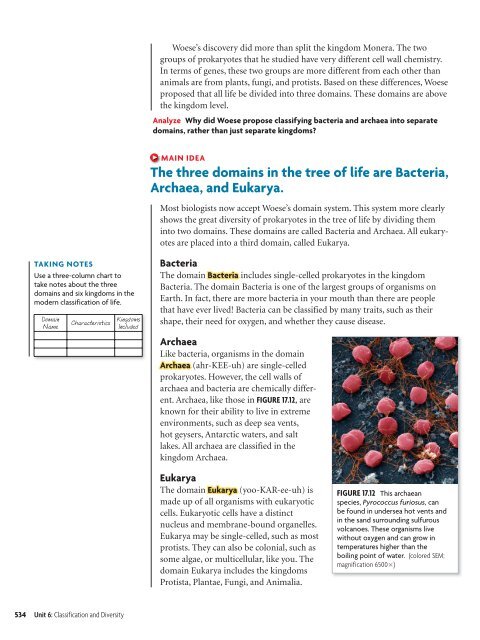Classification and Diversity
Classification and Diversity
Classification and Diversity
You also want an ePaper? Increase the reach of your titles
YUMPU automatically turns print PDFs into web optimized ePapers that Google loves.
Woese’s discovery did more than split the kingdom Monera. The two<br />
groups of prokaryotes that he studied have very different cell wall chemistry.<br />
In terms of genes, these two groups are more different from each other than<br />
animals are from plants, fungi, <strong>and</strong> protists. Based on these differences, Woese<br />
proposed that all life be divided into three domains. These domains are above<br />
the kingdom level.<br />
Analyze Why did Woese propose classifying bacteria <strong>and</strong> archaea into separate<br />
domains, rather than just separate kingdoms?<br />
MAIN IDEA<br />
The three domains in the tree of life are Bacteria,<br />
Archaea, <strong>and</strong> Eukarya.<br />
Most biologists now accept Woese’s domain system. This system more clearly<br />
shows the great diversity of prokaryotes in the tree of life by dividing them<br />
into two domains. These domains are called Bacteria <strong>and</strong> Archaea. All eukaryotes<br />
are placed into a third domain, called Eukarya.<br />
TAKING NOTES<br />
Use a three-column chart to<br />
take notes about the three<br />
domains <strong>and</strong> six kingdoms in the<br />
modern classification of life.<br />
Domain<br />
Name<br />
Characteristics<br />
Kingdoms<br />
Included<br />
Bacteria<br />
The domain Bacteria includes single-celled prokaryotes in the kingdom<br />
Bacteria. The domain Bacteria is one of the largest groups of organisms on<br />
Earth. In fact, there are more bacteria in your mouth than there are people<br />
that have ever lived! Bacteria can be classified by many traits, such as their<br />
shape, their need for oxygen, <strong>and</strong> whether they cause disease.<br />
Archaea<br />
Like bacteria, organisms in the domain<br />
Archaea (ahr-KEE-uh) are single-celled<br />
prokaryotes. However, the cell walls of<br />
archaea <strong>and</strong> bacteria are chemically different.<br />
Archaea, like those in FIGURE 17.12, are<br />
known for their ability to live in extreme<br />
environments, such as deep sea vents,<br />
hot geysers, Antarctic waters, <strong>and</strong> salt<br />
lakes. All archaea are classified in the<br />
kingdom Archaea.<br />
Eukarya<br />
The domain Eukarya (yoo-KAR-ee-uh) is<br />
made up of all organisms with eukaryotic<br />
cells. Eukaryotic cells have a distinct<br />
nucleus <strong>and</strong> membrane-bound organelles.<br />
Eukarya may be single-celled, such as most<br />
protists. They can also be colonial, such as<br />
some algae, or multicellular, like you. The<br />
domain Eukarya includes the kingdoms<br />
Protista, Plantae, Fungi, <strong>and</strong> Animalia.<br />
FIGURE 17.12 This archaean<br />
species, Pyrococcus furiosus, can<br />
be found in undersea hot vents <strong>and</strong><br />
in the s<strong>and</strong> surrounding sulfurous<br />
volcanoes. These organisms live<br />
without oxygen <strong>and</strong> can grow in<br />
temperatures higher than the<br />
boiling point of water. (colored SEM;<br />
magnification 6500)<br />
534 Unit 6: <strong>Classification</strong> <strong>and</strong> <strong>Diversity</strong>

















